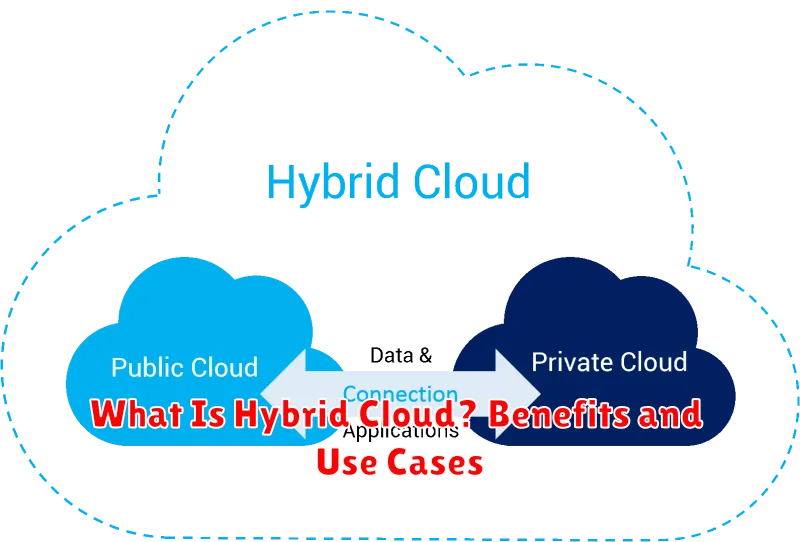In today’s rapidly evolving technological landscape, businesses are constantly seeking innovative solutions to optimize their IT infrastructure. One such solution that has gained significant traction is hybrid cloud. But what exactly is a hybrid cloud? This article delves into the core concepts of hybrid cloud, exploring its definition, examining its numerous benefits, and highlighting various real-world use cases. Understanding hybrid cloud is crucial for organizations looking to leverage the strengths of both public cloud and private cloud environments.
Hybrid cloud offers a strategic approach to managing IT resources by combining the flexibility and scalability of public cloud with the security and control of private cloud. This blended approach enables organizations to tailor their cloud strategy to specific business needs, optimizing cost efficiency while ensuring data security and compliance. We will explore the key advantages of adopting a hybrid cloud model, including enhanced scalability, improved disaster recovery capabilities, and increased flexibility in workload management. Furthermore, we will examine practical hybrid cloud use cases across diverse industries, illustrating how this powerful solution can transform business operations.
Understanding the Hybrid Cloud Model
A hybrid cloud model combines the strengths of both public and private cloud environments. It allows organizations to maintain sensitive data and applications within a secure, privately controlled infrastructure while leveraging the scalability and cost-effectiveness of a public cloud provider for less critical workloads.
This flexibility enables businesses to optimize resource allocation and adapt to changing needs. For instance, a company might store customer data on a private cloud for enhanced security and compliance, while utilizing a public cloud for development and testing environments or for bursting excess workload during peak demand.
Interoperability is a key aspect of a successful hybrid cloud setup. Seamless data and application portability between the private and public components is crucial for efficient operations. This requires careful planning and integration of technologies to ensure compatibility and secure data transfer.
Hybrid cloud offers a balanced approach, allowing organizations to tailor their cloud strategy to specific business requirements. It delivers enhanced control, improved security, and greater flexibility compared to solely relying on a single cloud deployment model.
Public vs Private vs Hybrid Cloud
Understanding the differences between public, private, and hybrid cloud models is crucial for choosing the right solution. Public clouds are owned and operated by third-party providers, offering services like storage and compute power over the internet. They are often cost-effective and scalable, making them ideal for startups and businesses with fluctuating needs.
Private clouds, on the other hand, are dedicated solely to a single organization. They can be hosted on-premises or by a third-party provider, offering greater control over security and compliance. This makes them suitable for businesses with stringent data regulations or sensitive information.
Hybrid clouds combine the best of both worlds, allowing organizations to leverage public cloud resources for less critical workloads while maintaining sensitive data on a private cloud. This provides flexibility, cost optimization, and increased security. The interplay between the public and private components is managed through advanced software and network connections.
Advantages of Hybrid Cloud Environments
Hybrid cloud solutions offer organizations several key advantages by combining the strengths of both public and private cloud models. One significant benefit is increased flexibility. Businesses can choose where to place their workloads based on specific needs, such as security requirements or regulatory compliance.
Enhanced scalability is another advantage. Organizations can leverage the public cloud’s resources to handle spikes in demand or seasonal workloads, while maintaining critical applications on their private cloud for greater control and security.
Cost optimization is also a driving factor for hybrid cloud adoption. By strategically placing workloads, businesses can reduce overall IT infrastructure costs. Less sensitive data can reside in the cost-effective public cloud, while mission-critical data remains in the private cloud.
Hybrid cloud provides improved security. Sensitive data and critical applications can be kept within the private cloud, ensuring greater control and adherence to regulatory compliance standards. Less sensitive workloads can utilize the public cloud, freeing up private cloud resources and enhancing overall security posture.
A hybrid cloud approach facilitates digital transformation by allowing organizations to experiment with new cloud-based technologies and services without disrupting existing on-premises infrastructure. This gradual migration path reduces risk and provides a flexible framework for innovation.
Typical Use Cases in Business

Hybrid cloud solutions offer businesses flexibility and scalability by combining public and private cloud resources. Several use cases highlight the advantages of this approach.
Disaster Recovery and Business Continuity: Hybrid cloud enables replication of critical data and applications to the public cloud, serving as a robust, cost-effective backup and recovery solution in case of outages in the primary data center.
Data and Application Modernization: Legacy systems can remain on a private cloud while new cloud-native applications reside on the public cloud, allowing for gradual modernization and integration without disrupting existing operations.
Scalable Computing and Storage: Businesses facing fluctuating demands, such as e-commerce platforms experiencing seasonal peaks, can leverage public cloud resources for additional computing power and storage, scaling back down during off-peak periods.
DevOps and Testing Environments: Hybrid cloud provides the flexibility to create development and testing environments quickly and efficiently in the public cloud, leveraging its on-demand resource provisioning while keeping sensitive production data secured within the private cloud.
Big Data Analytics: Large datasets can be transferred to the public cloud for processing and analysis using powerful cloud-based tools, with results then integrated back into the private cloud environment.
Challenges of Implementation
While hybrid cloud offers significant advantages, its implementation comes with inherent challenges. Security concerns are paramount, as managing data across different environments requires robust and consistent security protocols. Data integration and interoperability can also be complex, requiring careful planning and execution to ensure seamless data flow between on-premises and cloud platforms.
Compliance with industry regulations and data sovereignty laws adds another layer of complexity, especially for organizations operating in multiple jurisdictions. Maintaining compatibility between legacy systems and cloud-based applications can be technically challenging and may necessitate significant upgrades or modifications. The need for specialized expertise in both on-premises and cloud technologies can also pose a challenge for some organizations.
Cost management can become difficult in a hybrid environment. Organizations need to carefully track spending across both environments to avoid unexpected expenses. Finally, vendor lock-in is a potential concern, as integrating with specific cloud providers may create dependencies that limit future flexibility.
Security and Compliance Considerations

Security and compliance are paramount when implementing a hybrid cloud strategy. Data security requires careful consideration due to the distribution of data across on-premises and cloud environments. Implementing consistent security policies and controls across both environments is crucial. This includes access control, encryption, and vulnerability management.
Compliance requirements vary depending on industry and location. Organizations must ensure their hybrid cloud solution adheres to relevant regulations, such as GDPR, HIPAA, or PCI DSS. This includes data residency, data sovereignty, and auditability. Maintaining visibility and control over data across both environments is essential for demonstrating compliance.
A well-defined security architecture is necessary to manage risks effectively. This architecture should encompass both the on-premises infrastructure and the cloud environment. Regular security assessments and penetration testing can help identify and address vulnerabilities. Incident response plans should be in place to handle security breaches swiftly and effectively, minimizing potential damage.
Is Hybrid Cloud Right for You?
Determining if a hybrid cloud strategy is suitable for your organization requires careful consideration of your specific needs and circumstances. There is no one-size-fits-all answer, and the decision depends on a variety of factors.
Security and compliance requirements play a crucial role. If you handle sensitive data subject to strict regulations, maintaining some workloads on-premises might offer greater control.
Cost is another important factor. While cloud services offer scalability and potential cost savings, migrating everything to the cloud might not be the most economical approach. A hybrid model allows you to optimize costs by strategically placing workloads.
Your existing IT infrastructure and expertise also influence the decision. Leveraging existing on-premises investments while gradually adopting cloud services can be a more manageable transition.
Finally, consider your future scalability needs. A hybrid cloud allows you to burst to the cloud during peak demand while maintaining core applications on-premises, providing flexibility for growth and unforeseen circumstances.

